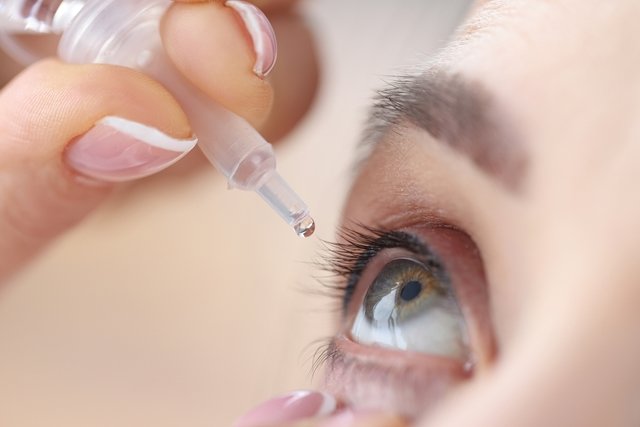Travoprost is an ophthalmological solution indicated for the treatment of ocular hypertension or open and closed angle glaucoma, as it reduces the pressure inside the eye within 2 hours after application.
This medicine is absorbed by the cornea and is believed to reduce intraocular pressure by increasing the flow of aqueous humor from the eye. One drop should be applied at night or as directed by an ophthalmologist.
Travoprost is offered free of charge by the SUS, as long as it has a medical indication, or it can be purchased in pharmacies or drugstores, under the names Travatan, Travamed or Travoptic. Furthermore, it can also be found in association with timolol maleate, under the names Duo-Travatan or Travamed-MT.

What is it for
Travoprost is indicated for:
- Ocular hypertension;
- Open-angle glaucoma;
- Angle-closure glaucoma, in people who have had iridotomy surgery.
This medicine helps to reduce pressure inside the eye, treating these conditions and should be used with the advice of an ophthalmologist and regular medical monitoring to assess the effectiveness of the treatment.
Furthermore, travoprost + timolol maleate may be indicated in cases where treatment with just a beta-blocker or prostaglandin analogue was not sufficient to reduce the pressure inside the eye, in cases of open-angle glaucoma or ocular hypertension.
If you would like to see an ophthalmologist, make an appointment in the nearest region:
Taking care of your health has never been easier!
How to use
Travoprost ophthalmic eye drops should only be used in the affected eye. It is important to avoid contacting the eye drop bottle with your eyes to avoid contaminating the solution.
The normally recommended dose for adults is to apply 1 drop of travoprost eye drops to the affected eye, once a day, preferably at night, to get the best effect of the medicine. It is important to apply the eye drops at the same time every day.
In the case of travoprost + timolol maleate, the recommended dose is 1 drop per day, in the morning or evening.
The reduction in intraocular pressure begins approximately 2 hours after application and the maximum effect is reached after 12 hours.
How to apply travoprost eye drops
To apply travoprost eye drops, you should tilt your head back slightly and pull the lower eyelid down to form a small pouch. Then, you must hold the eye drop bottle above the eye with the tip facing down, look up and squeeze the bottle so that the drop falls into the affected eye.
After applying travoprost eye drops, you should close your eye for about 2 minutes, without blinking and press your finger gently on the inner corner of the eye, to prevent the eye drops from running into the tear duct and being absorbed by the body, which which may increase the risk of side effects.
If the doctor has recommended the use of other eye drops, you should wait about 5 minutes between applications.
Possible side effects
The most common side effects of travoprost are eye discomfort, foreign body sensation, itching, redness in the eyes and decreased vision.
Although it is rarer, inflammation of the eyelid, cataracts, conjunctivitis, dry eye, keratitis, increased sensitivity to light and excessive tearing can also occur.
In addition to ophthalmological adverse effects, other non-ocular effects may occur that occur less frequently, such as angina, arthritis, back pain, bronchitis, gastrointestinal changes, headache and hypo- or hypertension.
Who shouldn’t use
Travoprost should not be used by people who are allergic to travoprost, benzalkonium chloride or any other component of the formula.
Furthermore, during pregnancy or breastfeeding, the use of travoprost is not recommended as there are not enough studies to prove the safety of this medicine at these stages. Therefore, it should only be used if recommended by a doctor, after evaluating the benefits for the woman and the possible risks for the baby.
Travoprost + timolol maleate should not be used by people with reactive respiratory diseases, such as bronchial asthma or severe COPD, or heart problems, such as sinus bradycardia, atrioventricular block, manifest heart failure or cardiogenic shock.

Sign up for our newsletter and stay up to date with exclusive news
that can transform your routine!
Warning: Undefined array key "title" in /home/storelat/public_html/wp-content/plugins/link-whisper-premium/templates/frontend/related-posts.php on line 12
Warning: Undefined array key "title_tag" in /home/storelat/public_html/wp-content/plugins/link-whisper-premium/templates/frontend/related-posts.php on line 13



